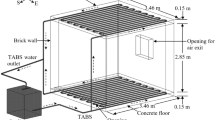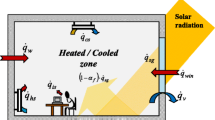Abstract
EnergyPlus (EP) integrates a low temperature radiant system module to evaluate thermal performance of radiant systems such as thermally activated building systems (TABS), but the assumptions in this module neglect thermal resistance of the pipe and thermal resistance between the pipe exterior surface and the pipe level, which may result in the inaccurate evaluation of TABS in terms of surface temperature and surface heat flow. In this paper, in order to validate this module used in EP, steady and transient heat transfer processes of TABS in buildings were studied by analytical solution, two-dimensional numerical simulation and EP simulation. The comparison shows that the assumptions indeed result in a largely overestimated cooling and heating capacity of TABS. In order to improve this radiant module, a simple solution of introducing a no mass material layer with the neglected thermal resistances to both sides of the pipe level was proposed. With this method, the results of mean surface temperature and mean heat flow show good agreement with that from analytical solution as well as numerical simulation. Furthermore, the results of the simulation coupling the modified module with room systems show very small deviation from the results found in the literature. In addition, the application of the modified module in a hollow core concrete deck structure with TABS was investigated.
Similar content being viewed by others
References
Chantrasrisalai C, Ghatti V, Fisher DE, Scheatzle DG (2003). Experimental validation of the EnergyPlus low-temperature radiant simulation. ASHRAE Transactions, 109(2): 614–623.
EnergyPlus (2012). EnergyPlus Manual, Documentation Version 7.2. US Department of Energy, USA.
Feng JJ, Schiavon S, Bauman F (2013). Cooling load differences between radiant and air systems. Energy and Buildings, 65: 310–321.
Feustel HE, Stetiu C (1995). Hydronic radiant cooling-preliminary assessment. Energy and Buildings, 22: 193–205.
Fort K (2001). TYPE 360: Floor Heating and Hypocaust. Available: http://www.trnsys.de/download/de/ts_type_360_de.pdf.
Henze GP, Felsmann C, Kalz DE, Herkel S (2008). Primary energy and comfort performance of ventilation assisted thermo-active building systems in continental climates. Energy and Buildings, 40: 99–111.
Holopainen R, Tuomaala P, Piippo J (2007). Uneven gridding of thermal nodal networks in floor heating simulations. Energy and Buildings, 39: 1107–1114.
Jin X, Zhang X, Luo Y, Cao R (2010). Numerical simulation of radiant floor cooling system: The effect of thermal resistance of pipe and water velocity on the performance. Building and Environment, 45: 2545–2552.
Koschenz M, Dorer V (1999). Interaction of an air system with concrete core conditioning. Energy and Buildings, 30: 139–145.
Koschenz M, Lehmann B (2000). Thermoaktive Bauteilsysteme Tabs. EMPA Energiesysteme/Haustechnik, Zurich. (in German)
Laouadi A (2004). Development of a radiant heating and cooling model for building energy simulation software. Building and Environment, 39: 421–431.
Flores Larsen S, Filippin C, Lesino G (2010). Transient simulation of a storage floor with a heating/cooling parallel pipe system. Building Simulation, 3: 105–115.
de Monte F (2000). Transient heat conduction in a one-dimensional composite slab. A ‘natural’ analytic approach. International Journal of Heat and Mass Transfer, 43: 3607–3619.
Olesen BW, Bonnefoi F, Michel E, Carli MD (2000). Heat exchange coefficient between floor surface and space by floor cooling: Theory or a question of definition. ASHRAE Transactions, 106(1): 684–694.
Olesen BW, Sommer K, Düchting B (2002). Control of slab heating and cooling systems studied by dynamic computer simulations. ASHRAE Transactions, 108(2): 698–707.
Olesen BW (2008). Radiant floor cooling systems. ASHRAE Journal, 50(9): 16–20.
Raftery P, Lee KH, Webster T, Bauman F (2012). Performance analysis of an integrated UFAD and radiant hydronic slab system. Applied Energy, 90: 250–257.
Rijksen DO, Wisse CJ, Schijndel AWMV (2010). Reducing peak requirements for cooling by using thermally activated building systems. Energy and Buildings, 42: 298–304.
Simões N, Tadeu A (2006). Transient conduction and convection heat transfer across a multi-layer floor subjected to multiple heat sources. Building and Environment, 41: 1299–1310.
Strand RK, Pedersen CO (1994). Analytical verification of heat source transfer functions. Presented at first Joint Conference of International Simulation Societies, Zurich, Switzerland.
Strand RK (1995). Heat source transfer functions and their application to low temperature radiant heating systems. PhD Dissertation, Department of Mechanical and Industrial Engineering, University of Illinois at Urbana-Champaign, USA.
Strand RK, Pedersen CO (2002). Modeling radiant systems in an integrated heat balance based energy simulation program. ASHRAE Transaction, 108(2): 979–988.
Stetiu C (1999). Energy and peak power saving potential of radiant cooling systems in US commercial buildings. Energy and Buildings, 30: 127–138.
Sun Y, Wichman IS (2004). On transient heat conduction in a one-dimensional composite slab. Internal Journal of Heat and Mass Transfer, 47: 1555–1559.
Tian Z, Love JA (2009), Energy performance optimization of radiant slab cooling using building simulation and field measurements. Energy and Buildings, 41: 320–330.
Zhang L, Liu XH, Jiang Y (2012). Simplified calculation for cooling/heating capacity, surface temperature distribution of radiant floor. Energy and Buildings, 55: 397–404.
Author information
Authors and Affiliations
Corresponding author
Rights and permissions
About this article
Cite this article
Yu, T., Heiselberg, P., Lei, B. et al. Validation and modification of modeling thermally activated building systems (TABS) using EnergyPlus. Build. Simul. 7, 615–627 (2014). https://doi.org/10.1007/s12273-014-0183-6
Received:
Revised:
Accepted:
Published:
Issue Date:
DOI: https://doi.org/10.1007/s12273-014-0183-6




